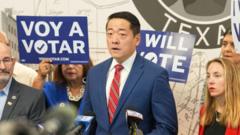The redistricting conflict between California and Texas highlights a significant political power struggle, as both states adopt measures to influence congressional representation. While Texas seeks to add Republican seats, California responds by redrawing its maps to boost Democratic numbers. This controversy raises important questions regarding gerrymandering and its impact on the upcoming midterm elections.
Redistricting Warfare: California and Texas in Political Power Struggle

Redistricting Warfare: California and Texas in Political Power Struggle
A heated battle unfolds as California and Texas engage in a contentious redistricting clash that may reshape political power in the U.S.
Lawmakers in California and Texas, the two most populous U.S. states with over 70 million residents, find themselves at the center of an escalating political battle that could drastically shift the power dynamics in Washington, D.C. Following Texas’s recent decision to draw five additional congressional seats favoring Republicans, California’s legislature swiftly retaliated by voting on a re-drawn map designed to counteract Texas’s advantage. This newly crafted California map is set to be presented to voters in November.
This intense political rivalry may seem perplexing, but it signals a wider trend that could influence other states as the national midterm elections approach next year. The standoff ignited in Texas when its Republican-dominated legislature chose to modify congressional districts halfway through the decade, strategically aimed at electing more Republicans to the House of Representatives. Texas’s primary objective was to secure five more congressional seats, enhancing their Republican representation. California’s countermeasure reflects their aim to gain five Democratic seats, directly responding to Texas’s actions.
Redistricting, the process where district boundaries are redrawn, plays a crucial role in the composition of the U.S. House of Representatives, which consists of 435 members elected biennially. The boundaries are determined by state governments, with some employing independent commissions and others leaving the process to the legislature. This determination can significantly affect the ideological leanings of districts, influencing which party is likely to win elections.
Currently, the balance in the House is precarious, with Democrats needing only three more seats for a majority. Historically, the president's party tends to lose seats in midterm elections, raising stakes for both factions. A shift in the House could enable Democrats to launch extensive investigations into presidential policies, similar to previous actions seen during Trump's presidency.
The debate over redistricting is particularly potent now, as both parties vie to reshape districts mid-decade to protect or implement their political agendas. Trump has rallied Republican leaders to redraw boundaries, aiming to avert potential losses in Congress during the upcoming midterms. However, this initiative faced challenges in Texas when Democratic lawmakers temporarily vacated the state to stall redistricting efforts, only returning after being threatened with arrest, leading to the eventual passage of the Republican-backed measure.
This redistricting is seen as a form of gerrymandering, where electoral boundaries are manipulated to benefit a specific political group. While both parties have engaged in this practice, legal standing is ambiguous unless racial bias is proven. Rarely has a sitting president openly supported such partisan maneuvers, intensifying scrutiny on Texas's actions.
Civil rights advocates have raised alarms that Texas's redistricting may disenfranchise minority voters, possibly contravening the Voting Rights Act, resulting in potential legal challenges. Critics argue that the system essentially allows politicians to choose their constituents, fostering unorthodox district shapes that group voters without consideration for geographical coherence.
Furthermore, as the 2026 midterm elections approach, redistricting could drastically influence the House's composition. States traditionally have taken varying approaches, with Democratic-led areas such as Illinois and New York preparing responses to counteract Texas's plan, whereas Republican-led states, including Indiana and Florida, are exploring similar strategies to bolster their congressional presence.
California's Governor Gavin Newsom has been vocal about mirroring Texas's initiative and has committed to aggressively pursue this path. However, California's process is hindered by a 2008 rule aimed at minimizing partisanship. On August 21, California legislators chose to place newly drawn maps on an upcoming special election ballot, a decision that could stir controversy given voters had previously mandated a nonpartisan commission to oversee map drawing.
New York’s situation is even more complex, as constitutional amendments would be required. Governor Kathy Hochul criticized Trump’s agenda and pledged to confront it directly. Experts indicate that states where Republicans hold greater power may find it easier to adjust congressional maps compared to Democratic-controlled regions, where protections against gerrymandering are more stringent. Even smaller states, though they hold less influence at the moment, may eventually join this fray as the stakes rise.





















